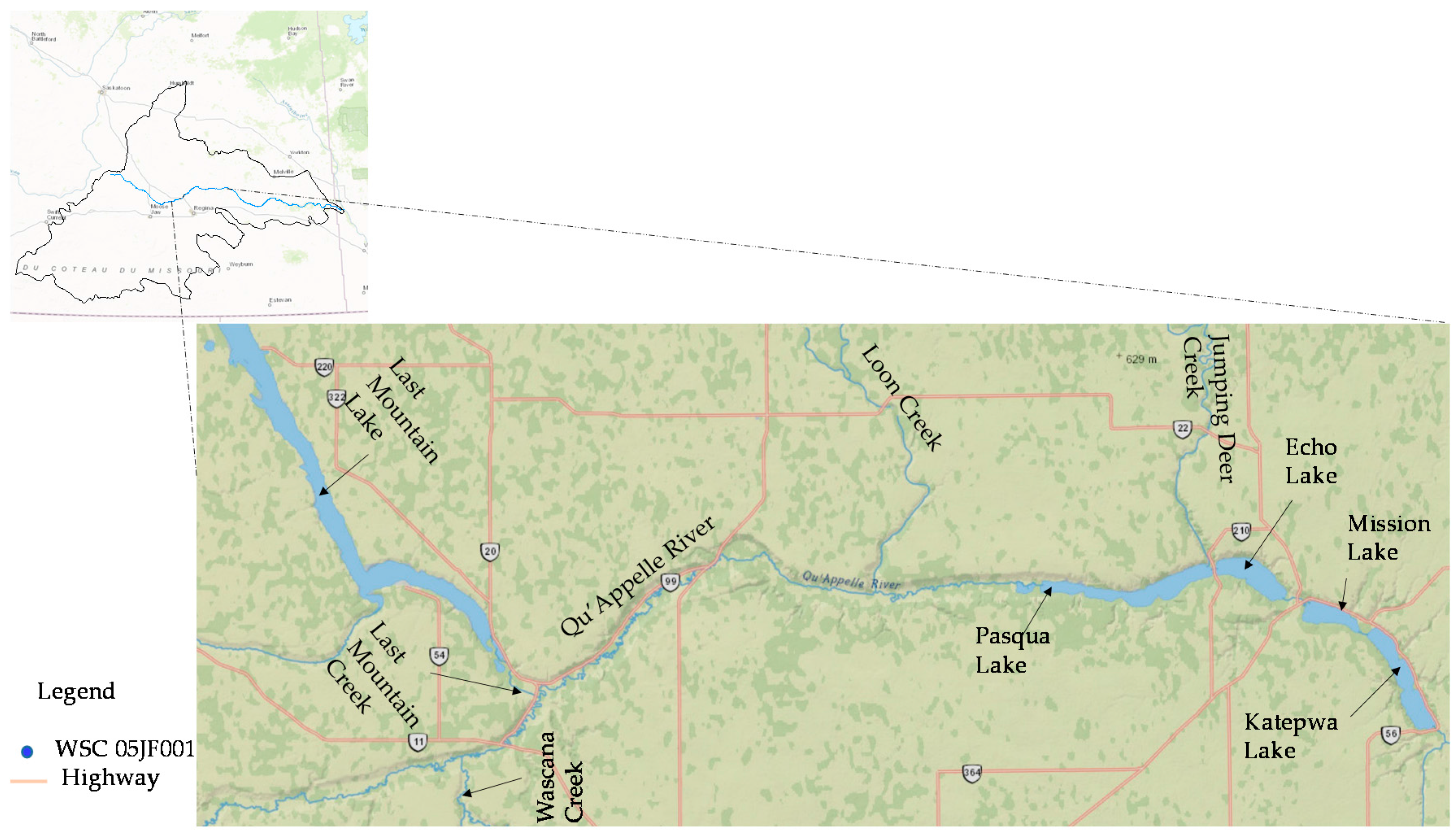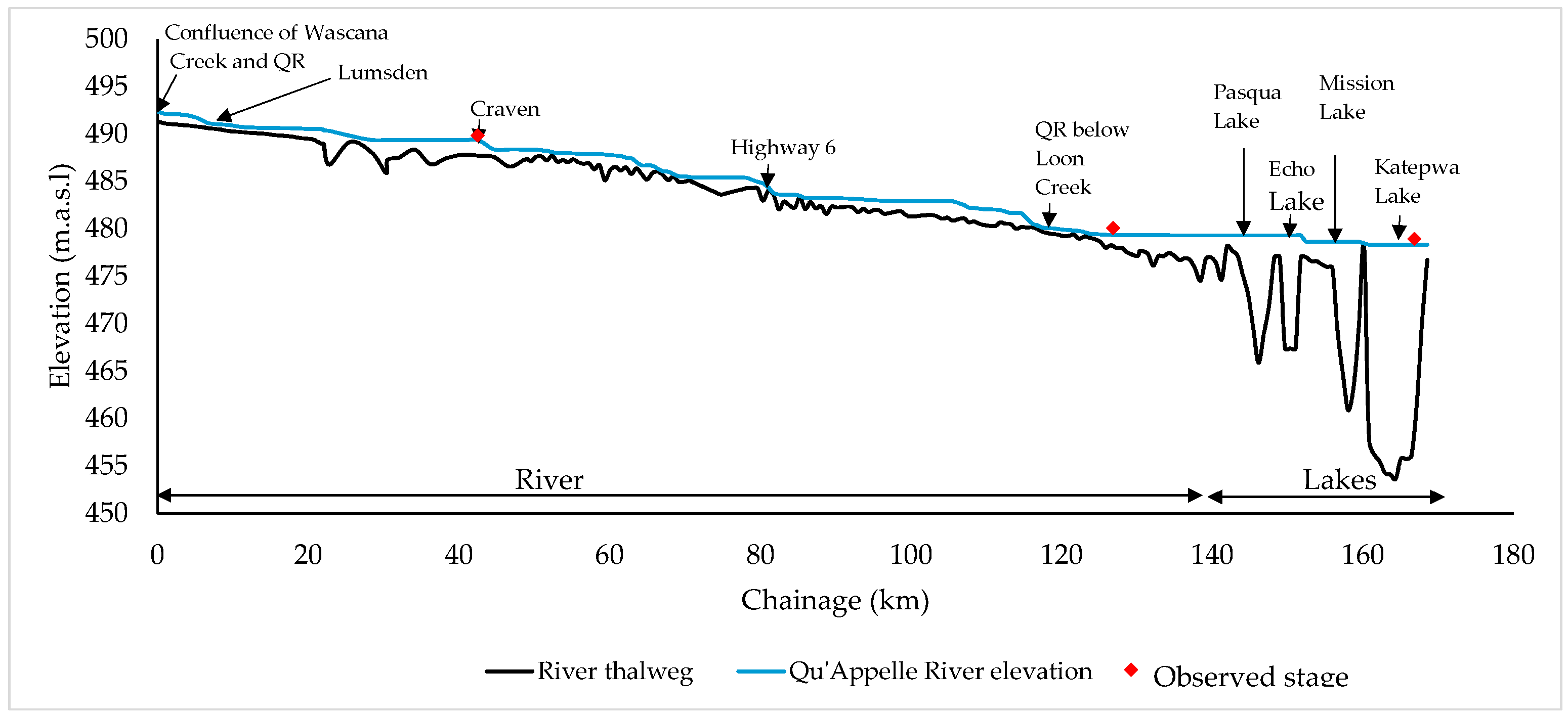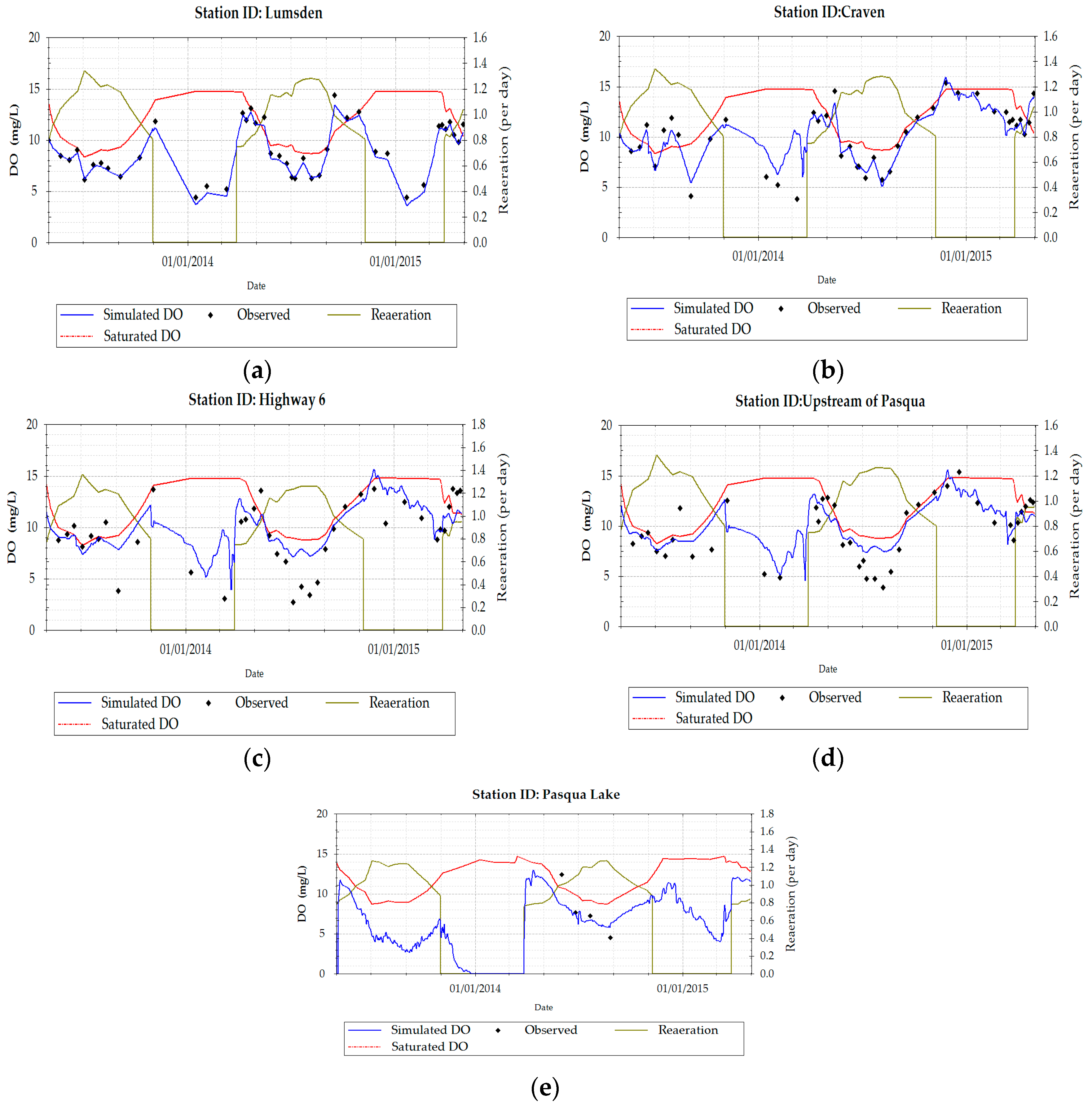Seasonal Variation in Sediment Oxygen Demand in a Northern Chained River-Lake System
Abstract
:1. Introduction
2. Materials and Methods
2.1. Overview of Study Area
2.2. Model Setup
| d(TBOD)/dt | = | Rate of change of the concentration of oxygen required to mineralize organic matter in mg/L/day. This is corrected before comparison with field BOD5 data |
| = | Oxygen demand due to the oxidization of newly produced organic matter per day, mg/L/day | |
| = | Deoxygenation rate at 20 °C, 1/day | |
| T | = | Water temperature, °C |
| θd | = | Temperature coefficient |
| d(DO)/dt | = | Rate of change of dissolved oxygen concentration, mg/L/day |
| θ2 | = | Temperature coefficient |
| DO | = | Dissolved oxygen concentration, mg/L |
| = | Total Biochemical oxygen demand in mg/L | |
| vs3 | = | Organic matter settling velocity, m/day |
| D | = | Average segment depth, m |
| f D5 | = | Fraction dissolved TBOD |
| = | Reaeration rate at 20 °C, 1/day | |
| DOs | = | DO solubility at temperature T, mg/L |
| SODT | = | Sediment oxygen demand rate at T, g/m2/day |
| θ | = | Temperature coefficient |
2.3. Advective Transport
2.4. Initial Condition
2.5. Boundary Condition
2.6. Calibration and Validation
3. Results and Discussion
3.1. Model Calibration and Validation
3.2. Spatial and Seasonal Variation of Sediment Oxygen Demand
4. Conclusions
Acknowledgments
Author Contributions
Conflicts of Interest
References
- Martin, N.; McEachern, P.; Yu, T.; Zhu, D.Z. Model development for prediction and mitigation of dissolved oxygen sags in the Athabasca River, Canada. Sci. Total Environ. 2013, 443, 403–412. [Google Scholar] [CrossRef] [PubMed]
- Zahraeifard, V.; Deng, Z. Modeling sediment resuspension-induced DO variation in fine-grained streams. Sci. Total Environ. 2012, 441, 176–181. [Google Scholar] [CrossRef] [PubMed]
- Liu, W. Measurement of sediment oxygen demand for modelling dissolved oxygen distribution in tidal Keelung River. Water Environ. J. 2009, 23, 100–109. [Google Scholar] [CrossRef]
- Tian, Y. A Dissolved Oxygen Model and Sediment Oxygen Demand Study in the Athabasca River. Master’s Thesis, University of Alberta, Edmonton, AB, Canada, 2005. [Google Scholar]
- MacPherson, T.A. Sediment Oxygen Demand and Biochemical Oxygen Demand: Patterns of Oxygen Depletion in Tidal Creek Sites. Master’s Thesis, University of North Carolina Wilmington, Wilmington, NC, USA, 2003. [Google Scholar]
- Rounds, S.; Doyle, M.C. Sediment Oxygen Demand in the Tualatin River Basin, Oregon, 1992–1996; US Department of the Interior, US Geological Survey: Porland, OR, USA, 1997.
- MacPherson, T.A.; Cahoon, L.B.; Mallin, M.A. Water column oxygen demand and sediment oxygen flux: Patterns of oxygen depletion in tidal creeks. Hydrobiologia 2007, 586, 235–248. [Google Scholar] [CrossRef]
- Hu, W.; Lo, W.; Chua, H.; Sin, S.; Yu, P. Nutrient release and sediment oxygen demand in a eutrophic land-locked embayment in Hong Kong. Environ. Int. 2001, 26, 369–375. [Google Scholar] [CrossRef]
- Matlock, M.D.; Kasprzak, K.R.; Osborn, G.S. Sediment oxygen demand in the Arroyo Colorado River. JAWRA J. Am. Water Resour. Assoc. 2003, 39, 267–275. [Google Scholar] [CrossRef]
- Higashino, M.; Gantzer, C.J.; Stefan, H.G. Unsteady diffusional mass transfer at the sediment/water interface: Theory and significance for SOD measurement. Water Res. 2004, 38, 1–12. [Google Scholar] [CrossRef] [PubMed]
- Haag, I.; Schmid, G.; Westrich, B. Dissolved Oxygen, and Nutrient Fluxes across the Sediment–Water Interface of the Neckar River, Germany: In Situ Measurements and Simulations. Water Air Soil Pollut. Focus 2006, 6, 413–422. [Google Scholar] [CrossRef]
- Diaz, R.J.; Rosenberg, R. Spreading Dead Zones and Consequences for Marine Ecosystems. Science 2008, 321, 926–929. [Google Scholar] [CrossRef] [PubMed]
- Chau, K. Field measurements of SOD and sediment nutrient fluxes in a land-locked embayment in Hong Kong. Adv. Environ. Res. 2002, 6, 135–142. [Google Scholar] [CrossRef]
- Rasheed, M.; Al-Rousan, S.; Manasrah, R.; Al-Horani, F. Nutrient fluxes from deep sediment support nutrient budget in the oligotrophic waters of the Gulf of Aqaba. J. Oceanogr. 2006, 62, 83–89. [Google Scholar] [CrossRef]
- Miskewitz, R.J.; Francisco, K.L.; Uchrin, C.G. Comparison of a novel profile method to standard chamber methods for measurement of sediment oxygen demand. J. Environ. Sci. Health Part A 2010, 45, 795–802. [Google Scholar] [CrossRef] [PubMed]
- Zeledon-Kelly, R.V. Effects of Landuse on Sediment Oxygen Demand for Streams in Northwest Arkansas and the Validation of a Sediment Oxygen Demand Measure-Plus-Calculate Model; ProQuest: Fayetteville, AR, USA, 2009. [Google Scholar]
- McDonnell, A.J.; Hall, S.D. Effect of environmental factors on benthal oxygen uptake. J. Water Pollut. Control Fed. 1969, 41, R353–R363. [Google Scholar]
- Mackenthun, A.A.; Stefan, H.G. Effect of flow velocity on sediment oxygen demand: Experiments. J. Environ. Eng. 1998, 124, 222–230. [Google Scholar] [CrossRef]
- Liu, W.; Chen, W. Monitoring sediment oxygen demand for assessment of dissolved oxygen distribution in river. Environ. Monit. Assess. 2012, 184, 5589–5599. [Google Scholar] [CrossRef] [PubMed]
- Caldwell, J.M.; Doyle, M.C. Sediment Oxygen Demand in the Lower Willamette River, Oregon; Water-Resources Investigations Report; U.S. Geological Survey: Portland, OR, USA, 1995.
- Paraska, D.W.; Hipsey, M.R.; Salmon, S.U. Sediment diagenesis models: Review of approaches, challenges and opportunities. Environ. Model. Softw. 2014, 61, 297–325. [Google Scholar] [CrossRef]
- Massoudieh, A.; Bombardelli, F.; Ginn, T.; Green, P.; Ferreira, R. Mathematical modeling of the biogeochemistry of dissolved and sediment-associated trace metal contaminants in riverine systems. In Proceedings of the International Conference on Fluvial Hydraulics, Lisbon, Portugal, 6–8 September 2006. [Google Scholar]
- Sohma, A.; Sekiguchi, Y.; Yamada, H.; Sato, T.; Nakata, K. A new coastal marine ecosystem model study coupled with hydrodynamics and tidal flat ecosystem effect. Mar. Pollut. Bull. 2001, 43, 187–208. [Google Scholar] [CrossRef] [PubMed]
- Sohma, A.; Sekiguchi, Y.; Nakata, K. Modeling and evaluating the ecosystem of sea-grass beds, shallow waters without sea-grass, and an oxygen-depleted offshore area. J. Mar. Syst. 2004, 45, 105–142. [Google Scholar] [CrossRef]
- Sohma, A.; Sekiguchi, Y.; Kuwae, T.; Nakamura, Y. A benthic–pelagic coupled ecosystem model to estimate the hypoxic estuary including tidal flat—Model description and validation of seasonal/daily dynamics. Ecol. Model. 2008, 215, 10–39. [Google Scholar] [CrossRef]
- Gualtieri, C. Sediment oxygen demand modeling in dissolved oxygen balance. In Proceedings of the International Conference on Environmental engineering and renewable energy, Ulaanbaatar, Mongolia, 7–10 September 1998. [Google Scholar]
- Slama, C.A. Sediment oxygen Demand and Sediment Nutrient Content of Reclaimed Wetlands in the Oil Sands Region of Northeastern Alberta. Master’s Thesis, University of Windsor, Windsor, ON, Canada, 2010. [Google Scholar]
- Boudreau, B.P. A method-of-lines code for carbon and nutrient diagenesis in aquatic sediments. Comput. Geosci. 1996, 22, 479–496. [Google Scholar] [CrossRef]
- Meysman, F.J.; Middelburg, J.J.; Herman, P.M.; Heip, C.H. Reactive transport in surface sediments. I. Model complexity and software quality. Comput. Geosci. 2003, 29, 291–300. [Google Scholar] [CrossRef]
- Bierman, V., Jr.; DePinto, J.; Dilks, D.; Moskus, P.; Slawecki, T.; Bell, C.; Chapra, S.; Flynn, K. Modeling Guidance for Developing Site-Specific Nutrient Goals; Water Environment Research Foundation: Alexandria, VA, USA, 2013. [Google Scholar]
- Wool, T.A.; Ambrose, R.B.; Martin, J.L.; Comer, E.A.; Tech, T. Water Quality Analysis Simulation Program (WASP). User’s Manual; U.S Environmental Protection Agency, Center for Exposure Assessment Modeling: Athens, GA, USA, 2006.
- Terry, J.A.; Sadeghian, A.; Lindenschmidt, K. Modelling Dissolved Oxygen/Sediment Oxygen Demand under Ice in a Shallow Eutrophic Prairie Reservoir. Water 2017, 9, 131. [Google Scholar] [CrossRef]
- Cox, L.A. Internal dose, uncertainty analysis, and complexity of risk models. Environ. Int. 1999, 25, 841–852. [Google Scholar] [CrossRef]
- Quinlan, R.; Leavitt, P.R.; Dixit, A.S.; Hall, R.I.; Smol, J.P. Landscape effects of climate, agriculture, and urbanization on benthic invertebrate communities of Canadian prairie lakes. Limnol. Oceanogr. 2002, 47, 378–391. [Google Scholar] [CrossRef]
- Hall, R.I.; Leavitt, P.R.; Quinlan, R.; Dixit, A.S.; Smol, J.P. Effects of agriculture, urbanization, and climate on water quality in the northern Great Plains. Limnol. Oceanogr. 1999, 44, 739–756. [Google Scholar] [CrossRef]
- United States Army Corps of Engineers, Hydrologic Engineering Center. HEC-RAS River Analysis System 2D Modelling User’s Manual Version 5.0; Hydrologic Engineering Center, United States Corps of Engineer: Davis, CA, USA, 2016. [Google Scholar]
- Ambrose, R.; Wool, T. WASP7 Stream Transport-Model Theory, and User’s Guide, Supplement to Water Quality Analysis Simulation Program (WASP) User Documentation; National Exposure Research Laboratory, Office of Research and Development, US Environmental Protection Agency: Athens, GA, USA, 2009.
- Akomeah, E.; Chun, K.P.; Lindenschmidt, K. Dynamic water quality modelling and uncertainty analysis of phytoplankton and nutrient cycles for the upper South Saskatchewan River. Environ. Sci. Pollut. Res. 2015, 22, 18239–18251. [Google Scholar] [CrossRef] [PubMed]
- Tolson, B.A.; Shoemaker, C.A. Dynamically dimensioned search algorithm for computationally efficient watershed model calibration. Water Resour. Res. 2007, 43, 208–214. [Google Scholar] [CrossRef]
- Chiaro, P.S.; Burke, D.A. Sediment oxygen demand and nutrient release. In Conference on Environmental Engineering: Research Development and Design, Proceedings of the Environmental Engineering Division Specialty Conference, Kansas City, MO, USA, 10–12 July 1978; American Society of Civil Engineers: Kansas City, MO, USA, 1978; pp. 313–322. [Google Scholar]
- James, A. The measurement of benthal respiration. Water Res. 1974, 8, 955–959. [Google Scholar] [CrossRef]
- Zhu, D.; Yu, T. Spatial variation of sediment oxygen demand in Athabasca River: Influence of water column pollutants. In Proceedings of the World Environmental and Water Resources Congress, Kansas City, MO, USA, 17–21 May 2009; pp. 1–12. [Google Scholar]
- Clifton Associates Ltd. Upper Qu’Appelle Water Supply Project: Economic Impact and Sensitivity Analysis; Water Security Agency: Regina, SK, Canada, 2012. [Google Scholar]
- McCulloch, J.; Gudimov, A.; Arhonditsis, G.; Chesnyuk, A.; Dittrich, M. Dynamics of P-binding forms in sediments of a mesotrophic hard-water lake: Insights from non-steady state reactive-transport modeling, sensitivity and identifiability analysis. Chem. Geol. 2013, 354, 216–232. [Google Scholar] [CrossRef]
- Maerki, M.; Müller, B.; Wehrli, B. Microscale mineralization pathways in surface sediments: A chemical sensor study in Lake Baikal. Limnol. Oceanogr. 2006, 51, 1342–1354. [Google Scholar] [CrossRef]
- United States Environmental Protection Agency. Technical Guidance Manual for Developing Total Maximum Daily Loads, Book 2: Streams and Rivers, Part 1: Biochemical Oxygen Demand and Nutrients/Eutrophication; U.S. EPA: Washington, DC, USA, 1995.
- Blais, J.M.; Kalff, J. The influence of Lake Morphometry on sediment focusing. Limnol. Oceanogr. 1995, 40, 582–588. [Google Scholar] [CrossRef]
- Babin, J.; Prepas, E. Modelling winter oxygen depletion rates in ice-covered temperate zone lakes in Canada. Can. J. Fish. Aquat. Sci. 1985, 42, 239–249. [Google Scholar] [CrossRef]
- Elwood, J.W.; Waters, T.F. Effects of floods on food consumption and production rates of a stream brook trout population. Trans. Am. Fish. Soc. 1969, 98, 253–262. [Google Scholar] [CrossRef]
- Thomann, R.V.; Mueller, J.A. Principles of Surface Water Quality Modeling and Control; Harper & Row: New York, NY, USA, 1987. [Google Scholar]
- Chambers, P.; Scrimgeour, G.; Pietroniro, A. Winter oxygen conditions in ice-covered rivers: The impact of pulp mill and municipal effluents. Can. J. Fish. Aquat. Sci. 1997, 54, 2796–2806. [Google Scholar] [CrossRef]
- Chapra, S.C. Surface Water-Quality Modeling; Waveland Press: Long Grove, IL, USA, 2008. [Google Scholar]






| Gauge Station | Mean Error | Mean Absolute Error |
|---|---|---|
| Lumsden | −0.32 | 0.35 |
| Craven | −0.03 | 0.77 |
| Highway 6 | 0.62 | 1.78 |
| Upstream of Pasqua | 0.36 | 1.36 |
| Pasqua | −0.62 | 1.30 |
| River Reach/Lake | Description | Optimum SOD (g/m2/Day) at 20 °C | Reported SOD Range | Reference |
|---|---|---|---|---|
| Reach 1 | Wascana-QR confluence to Lumsden | 1.90 | (0.1–5.3) (SOD) | [40] 2 |
| (1.04–1.13) (Temp. coefficient) | [50] | |||
| Reach 2 | Lumsden to Craven | 1.70 | (0.1–5.3) | [40] |
| Reach 3 | Craven to Highway 6 | 0.79 | (0.1–5.3) | [40] |
| Reach 4 | Highway 6 to Qu’Appelle below Loon Creek | 0.98 | (0.1–5.3) | [40] |
| Lakes | Pasqua, Echo Mission, Katepwa lakes | 2.20 | (0.7–8.4) | [41] 3 |
© 2017 by the authors. Licensee MDPI, Basel, Switzerland. This article is an open access article distributed under the terms and conditions of the Creative Commons Attribution (CC BY) license (http://creativecommons.org/licenses/by/4.0/).
Share and Cite
Akomeah, E.; Lindenschmidt, K.-E. Seasonal Variation in Sediment Oxygen Demand in a Northern Chained River-Lake System. Water 2017, 9, 254. https://doi.org/10.3390/w9040254
Akomeah E, Lindenschmidt K-E. Seasonal Variation in Sediment Oxygen Demand in a Northern Chained River-Lake System. Water. 2017; 9(4):254. https://doi.org/10.3390/w9040254
Chicago/Turabian StyleAkomeah, Eric, and Karl-Erich Lindenschmidt. 2017. "Seasonal Variation in Sediment Oxygen Demand in a Northern Chained River-Lake System" Water 9, no. 4: 254. https://doi.org/10.3390/w9040254






